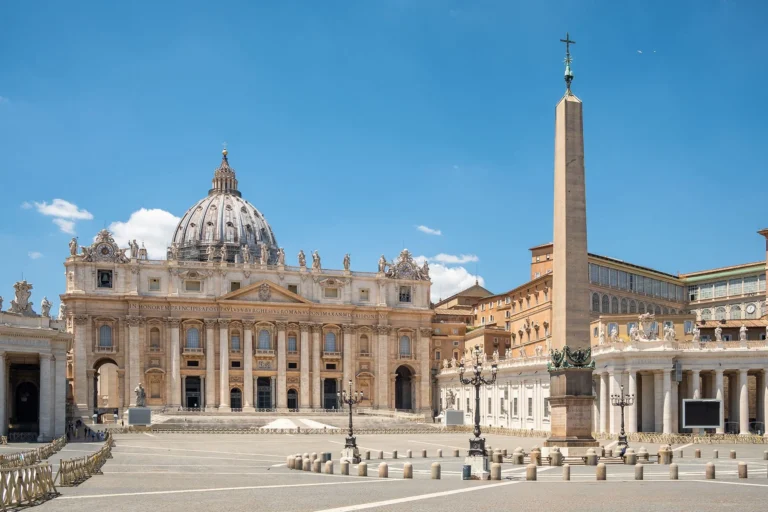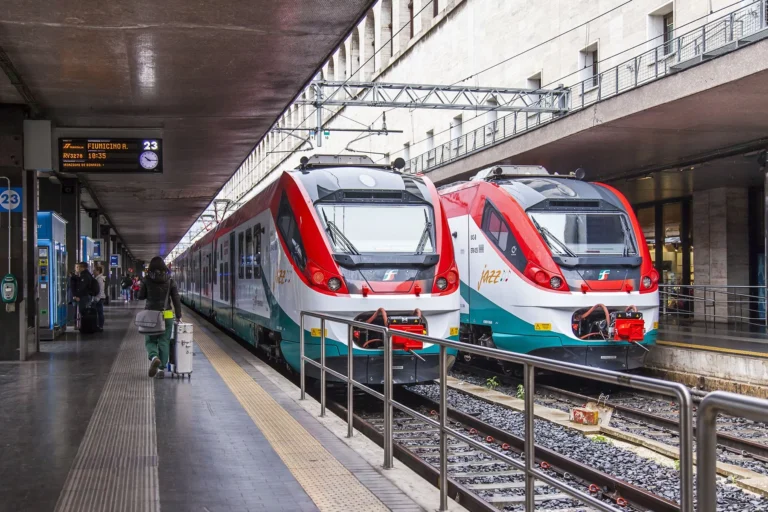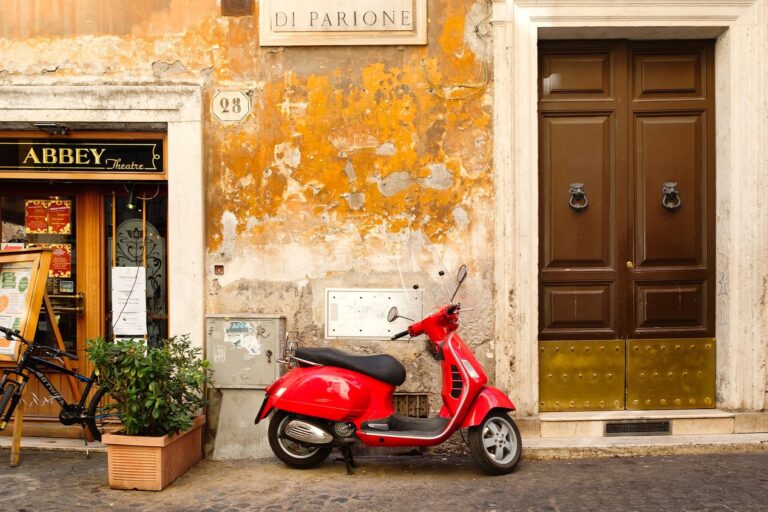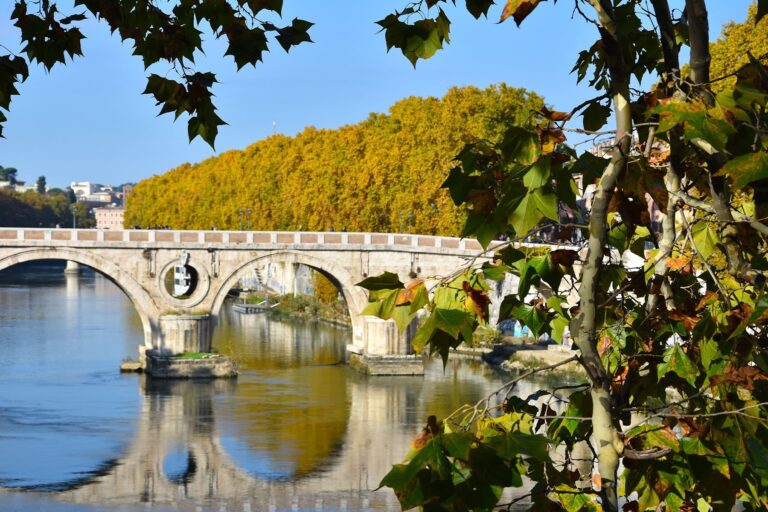Near Vatican City in the center of Rome, on the left bank of the Tiber River, lies Castel Sant’Angelo. This popular landmark in Rome is also known as the Mausoleum of Hadrian or the Castle of the Holy Angel. The striking building is one of Rome’s most famous structures and gained worldwide fame thanks to Dan Brown’s thrilling novel “Angels and Demons” or the film adaptation where the castle plays a crucial role in the story.
Over time, the building has served various purposes. It was originally built as a mausoleum, but it has also functioned as a fortress, military prison, and even as a papal residence.
Visiting Castel Sant’Angelo in Rome
The Castel Sant’Angelo includes a cylindrical tower with a diameter of 64 meters and totals 6 floors with 58 different rooms that guide you through the history of the fortress. Not only is the exterior a must-see, but the interior of the Castel Sant’Angelo is highly recommended as well.
You can explore the damp cells of the complex, visit a museum, and see the luxurious apartments of the Renaissance popes. In the Sala di Perseo, you can admire several 17th-century Flemish tapestries. Additionally, in the Sala di Adriano, you’ll find the painting “The Education of Bacchus,” created by a pupil of Rubens.
The following five floors are accessible to the public:
- Ground floor: Here you’ll find a courtyard with exhibitions of medieval weapons.
- 1st floor: This floor houses the mausoleum, including the tombs of Emperor Hadrian. Unfortunately, some of the tombs were plundered over time.
- 2nd floor: This floor served as a prison and storage area for grain and oil.
- 3rd floor: On this level, you’ll find the military museum where you can admire weapons, furniture, and paintings.
- 4th floor: Here are the papal apartments where popes could seek refuge when it was too dangerous to stay in the Vatican. You can also find the rooms of Pope Paul III, Clement VII, and Leo X here.
- 5th floor: On top of the Castel Sant’Angelo is a large terrace offering panoramic views of Rome.
The Castel Sant’Angelo is in the Parco della Mole Adriana, a beautiful park where you can enjoy pleasant walks or picnics, especially in spring and summer, after visiting the fortress.
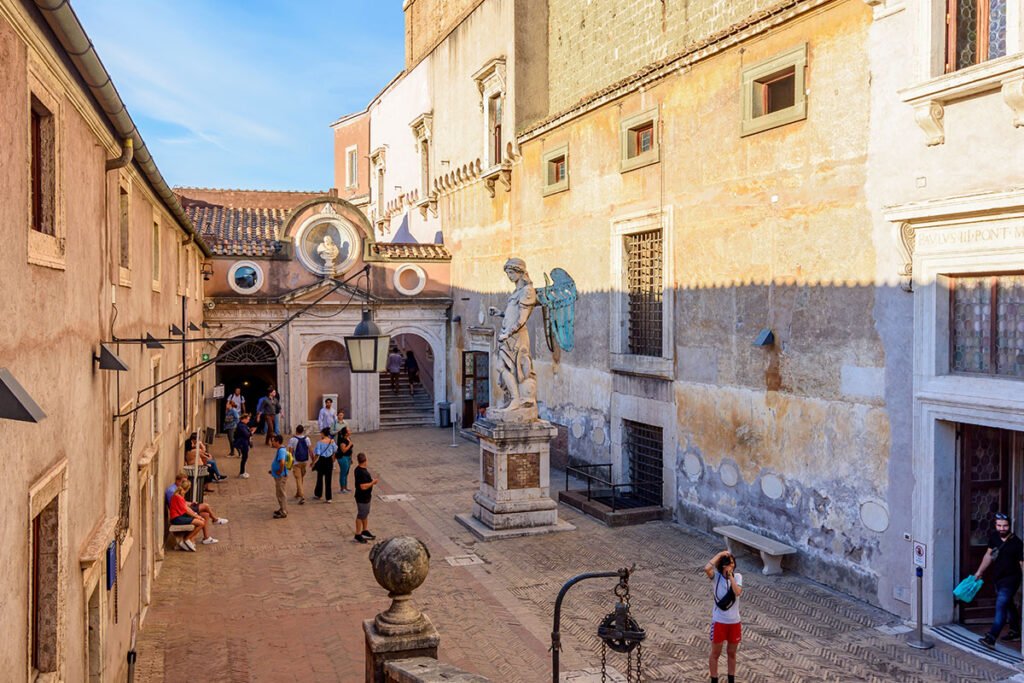
History of Castel Sant’Angelo
Castel Sant’Angelo was commissioned by Emperor Hadrian in the year 130 AD. He intended to create a mausoleum for himself, his family, and his successors. By 139 AD, the construction of the mausoleum was completed, although Emperor Hadrian passed away a year before its completion. Despite this, the ashes of Hadrian, along with those of his wife and adopted son, were placed inside the mausoleum.
Thus began a tradition of interring the remains of fallen emperors in the mausoleum. The last emperor to be interred there was Emperor Caracalla in 217 AD. His name is well-known today due to the baths bearing his name that were built under his rule.
Name of the Castel Sant’Angelo
Castel Sant’Angelo derives its name from the Archangel Michael. In 590 AD, its name was associated with the archangel after Pope Gregory I saw in a vision how the archangel, after the plague epidemic, sheathed his sword atop the mausoleum to end the epidemic in the city.
As a tribute, the angel was given a prominent place at the highest point of Castel Sant’Angelo. Initially, a marble statue was created by Montelupo in 1536, but this was replaced in 1753 by a bronze statue created by Pieter Antoon Verschaffelt. You can find the bronze statue on the rooftop terrace on the fifth floor of the fortress. The marble statue was relocated to the square in Castel Sant’Angelo after the arrival of the bronze statue.
Fortress and Prison
At the beginning of the 5th century, the mausoleum was transformed into a fortress with the construction of the Aurelian Walls. Due to this transformation, a large number of tombs and decorations from the original mausoleum were unfortunately lost.
The walls were built around the mausoleum due to its strategic location along the Tiber River. Despite its use as a defense of Rome, the fortress was plundered by the Visigoths in 410 AD, resulting in the destruction of many urns and artworks. In 537 AD, the fortress was attacked by the Goths, and in defense, a large number of bronze and stone statues were thrown at the invaders from the wall surrounding the fortress. After this attack, only one capstone of the tombs remained intact, the stone of Hadrian. This stone was later used in the tomb of Pope Otto II in St. Peter’s Basilica in Vatican City.
In addition to being a mausoleum, Castel Sant’Angelo was also used for a long time as a prison, where prisoners were even executed or killed by the stake or guillotine. Two notable prisoners were the sculptor Benvenuto Cellini and the philosopher and cosmologist Giordano Bruno. Bruno was sentenced to death by burning at the stake at Campo de’ Fiori after more than seven years of imprisonment due to charges related to important Catholic doctrines. Cellini was wrongly imprisoned for a long time for stealing gems from the pope’s tiara. Initially sentenced to death, he was eventually acquitted thanks to Cardinal d’Este of Ferrara.
The prison can still be visited today on the second floor of Castel Sant’Angelo, where you can see the original cells among other features.
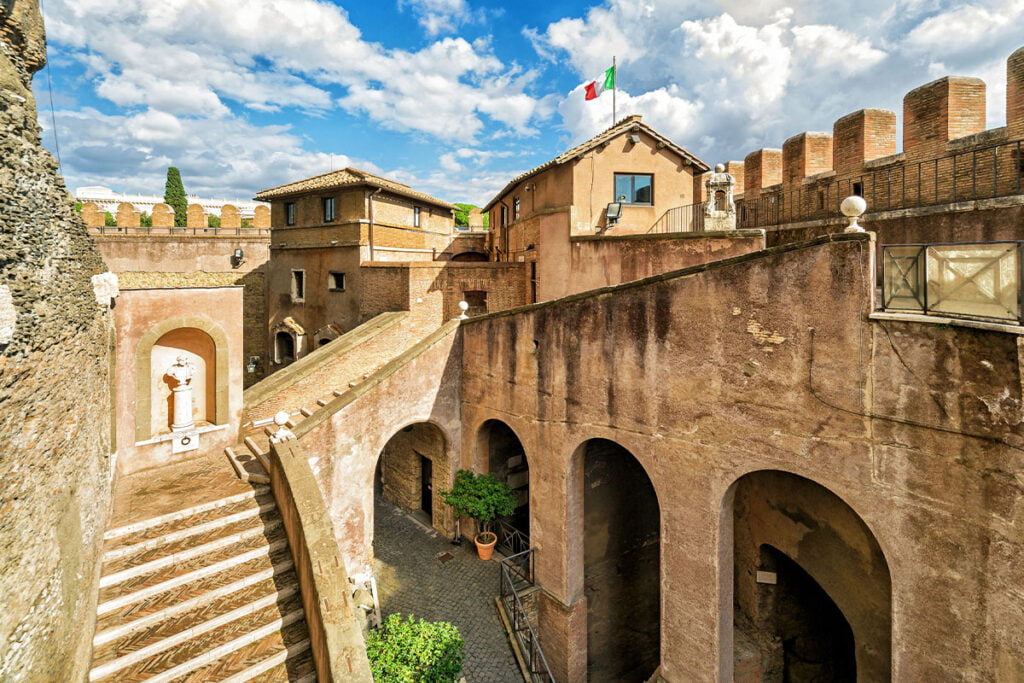
Museo Nazionale di Castel Sant’Angelo
Over the years, Castel Sant’Angelo has served various functions, but since 1901, the fortress has officially housed the military museum known as Museo Nazionale di Castel Sant’Angelo. Located on the 3rd floor of the fortress, the museum features a collection including weapons, pottery, ancient artifacts, paintings, and Renaissance furniture.
Most of the artworks in the museum are borrowed from the collections of Contini Bonacossi and Mario Menotti. One of the highlights of the museum is the original marble statue of Saint Michael, located in the Cortile dell’Angelo.
Papal Apartments and the Secret Passage
On the fourth floor of Castel Sant’Angelo, you can find the papal apartments of Popes Paul III, Clement VII, Clement VIII, and Leo Clemens X. These luxurious apartments were commissioned by Pope Paul III so that popes could retreat to the fortified fortress in times of danger. There is a secret underground passage leading from the Vatican to Castel Sant’Angelo, constructed under the orders of Pope Nicholas III in 1277 as an escape route for popes to quickly reach safety.
Also on the fourth floor is the Chamber of Justice, where prisoners were once sentenced. Among others, Giordano Bruno was condemned to death by burning at the stake by Pope Clement VII after 7 years of imprisonment for charges related to significant Catholic doctrines.
The Secret Passage
One of the remarkable features of Castel Sant’Angelo is a secret passage that runs underground from the Vatican, starting from St. Peter’s Basilica and leading to Castel Sant’Angelo. This passage, known as the Passetto di Borgo, was constructed by Pope Nicholas III in 1277 as an escape route. Pope Clement VII was also brought to safety through this passage during the siege by Charles V.
Since the Vatican was outside the walled city, it was vulnerable and difficult to defend. The secret passage allowed popes to escape quickly from the Vatican to the secure fortress of Castel Sant’Angelo during times of danger. It also facilitated the safe transfer of valuable church treasures to Castel Sant’Angelo.
The underground corridor was used by Pope Clement VII during the Sack of Rome in 1527. Later, special apartments were built in Castel Sant’Angelo by Pope Paul III so that popes could stay in the same luxury in the fortress as they did in the Vatican during emergencies.
The unique secret passage plays a significant role in Dan Brown’s famous book “Angels and Demons” and its film adaptation. Castel Sant’Angelo itself features prominently in both the book and the film because the Chapel of the Illuminati is located within the fortress.
Rooftop Terrace
On the fifth floor of Castel Sant’Angelo, you will find the rooftop terrace where you can not only see the bronze statue of Archangel Michael but also enjoy a magnificent panoramic view of Rome, the Ponte Sant’Angelo, and the Vatican.

Tickets Castel Sant’Angelo
Are you planning to visit Castel Sant’Angelo in Rome? Then you’ll need a ticket, which you can purchase on-site or online. Please note that on-site tickets often require cash payment.
It’s advisable to reserve your tickets in advance online, especially during peak season when queues at the ticket office can be long. By booking special skip-the-line tickets online, you can bypass the queue at the ticket counter and enter directly, saving you a lot of time.
You can reserve skip-the-line tickets for Castel Sant’Angelo in Rome online by the Tiqets website. Tickets for Castel Sant’Angelo cost 23 euros for adults (18 years and older) and 3,50 euros for children up to 17 years old.
It’s best to avoid visiting Castel Sant’Angelo on the first Sunday of the month, as admission is free on this day and it tends to be extra crowded. Additionally, visiting early in the morning just after opening or later in the afternoon or evening is recommended. With good planning, you can even enjoy the sunset from Castel Sant’Angelo.
Click here to reserve your tickets online
Organized Tour of Castel Sant’Angelo
If you want to learn everything about Castel Sant’Angelo, its unique architecture, and its history, consider booking a guided tour tour where you’ll explore the fortress with an experienced English-speaking guide.
On GetYourGuide, you can book a combined ticket for a guided tour to Castel Sant’Angelo and St. Peter’s Square. The tour lasts three hours in total, during which you’ll discover everything about the iconic square in Vatican City and the history of Castel Sant’Angelo. The tour costs 55 euros for adults and 50 euros for young adults aged 18 to 25. You can book the organized tour to Castel Sant’Angelo by the GetYourGuide website.
There is also a more affordable guided tour of Castel Sant’Angelo in Rome available. Priced at 36 euros per person, this tour includes fast-track access to the museum and a 1-hour guided tour led by an experienced guide. You can book this quick tour including priority ticket by this link.
Roma Pass – Free Public Transport
Are you planning to visit Castel Sant’Angelo in Rome and intend to use public transport frequently? Then the Roma Pass is perfect for you! With the Roma Pass, you can enjoy unlimited use of public transport in Rome for either 48 or 72 hours. Additionally, this special discount card provides free admission to one or two museums in Rome, including Castel Sant’Angelo and the Colosseum. Opting for the 48-hour Roma Pass allows you to visit one attraction for free, while the 72-hour pass allows access to two attractions.
You can easily book the Roma Pass online via the Tiqets website. Upon booking, you will receive a voucher code that can be exchanged at various locations in Rome, including the airport, to collect your Roma Pass. More information about the Roma Pass can be found on our “Roma Pass page.”
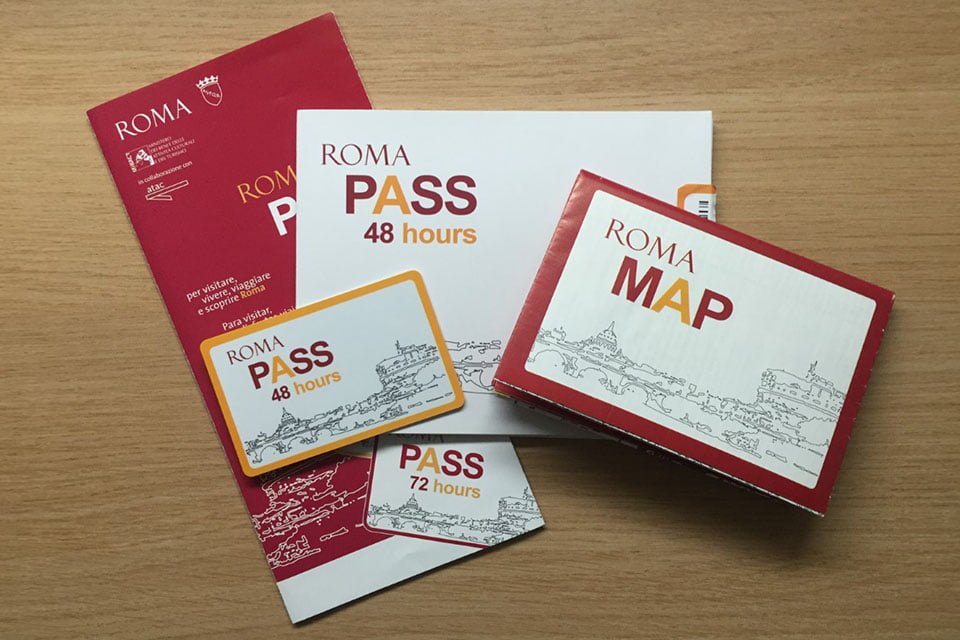
Opening Hours and how to get there
Castel Sant’Angelo is open throughout the year from Tuesday to Sunday; it is closed on Mondays. On January 1st, May 1st, and December 25th, Castel Sant’Angelo is closed due to holidays. Visiting hours are from 9:00 AM to 7:30 PM, with the ticket office closing at 6:30 PM.
During the summer months from July to September, Castel Sant’Angelo offers evening visits as well. You can visit the castle in central Rome from 8:30 PM to 1:00 AM. Please note that these dates and times may have changed, so always check locally for the most current opening hours.
Metro
Due to its central location in Rome, Castel Sant’Angelo is easily accessible by public transport. You can reach it conveniently by taking Metro Line A and getting off at Lepanto station, which is about 1 kilometer from the castle. From there, it’s a short 15-minute walk to Castel Sant’Angelo.
Bus
Another option to reach Castel Sant’Angelo is by bus. Bus lines 23, 40, 62, 271, 280, and 982 stop at Piazza Pia; bus lines 49, 87, 926, and 990 stop at Piazza Cavour; and lines 46 and 64 stop at Santo Spirito. It’s a short 5 to 10-minute walk from each of these stops to Castel Sant’Angelo.
Walking and Driving
Of course, you can also reach Castel Sant’Angelo on foot. It takes about 15 minutes to walk from Vatican City to Castel Sant’Angelo, which is circa 1 kilometer from St. Peter’s Square. From the Colosseum, it’s a leisurely 30-minute walk to Castel Sant’Angelo. The walk to Castel Sant’Angelo also takes you past other highlights of Rome and through its most beautiful historical streets.
While not recommended, if you prefer to drive to Castel Sant’Angelo, the best place to park is at Piazza Cavour. From there, it’s about a 5-minute walk to Castel Sant’Angelo.
